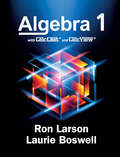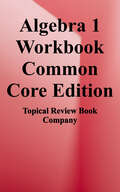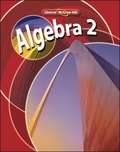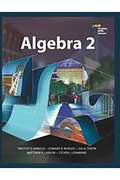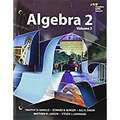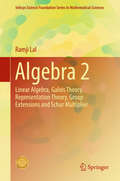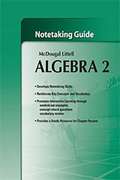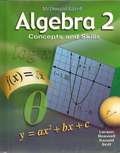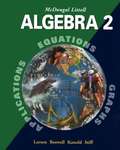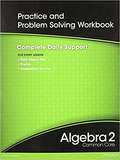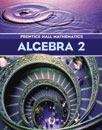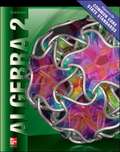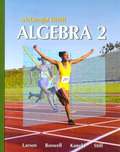- Table View
- List View
Algebra 1 Workbook: Common Core Standards Edition
by Topical Review Book CompanyUPDATED TO INCLUDE August 2019 EXAMS PRACTICE TEST REVIEW BOOK — Each booklet contains the most recent NYS Regents tests that are aligned with the Common Core standards of Geometry. Books are updated twice annually, in March and September. Each booklet is self contained with spaces for student answers.
Algebra 2
by John A. Carter Gilbert J. Cuevas Roger DayTHE PROGRAM STUDENTS NEED; THE FOCUS TEACHERS WANT! "Glencoe Algebra 2" is a key program in our vertically aligned high school mathematics series developed to help all students achieve a better understanding of mathematics and improve their mathematics scores on today's high-stakes assessments.
Algebra 2: Integration, Applications, Connections
by William Colluns Gilbert Cuevas Alan G. Foster Berchie Gordon Beatrice Moore-Harms James Rath Dora Swart Lesue J. WintersAlgebra 2 is designed to illustrate how algebra is used in the real world. This goal is accomplished through integration, applications, and connections and the book also talks about how different branches of mathematics, such as geometry and statistics, are interrelated.
Algebra 2: Chapters A And B (Merrill Algebra 2 Series)
by Gilbert Cuevas John Carter Roger DayNIMAC-sourced textbook
Algebra 2
by Haenisch A. G. S. SecondarySpecially written for low-level learners, Algebra 2 covers several methods for solving quadratic equations, such as factoring, completing the square, and graphing. The text also introduces trigonometry and exponential functions—vital concepts for real world applications. Filled with full-color illustrations and examples throughout, Algebra 2 motivates students to learn.
Algebra 2: Interactive Student Edition (Volume #2)
by Timothy D. Kanold Edward B. Burger Juli K. DixonVolume 2 of this HMH Algebra 2 text. NIMAC-sourced textbook
Algebra 2: Linear Algebra, Galois Theory, Representation theory, Group extensions and Schur Multiplier (Infosys Science Foundation Series)
by Ramji LalThis is the second in a series of three volumes dealing with important topics in algebra. Volume 2 is an introduction to linear algebra (including linear algebra over rings), Galois theory, representation theory, and the theory of group extensions. The section on linear algebra (chapters 1-5) does not require any background material from Algebra 1, except an understanding of set theory. Linear algebra is the most applicable branch of mathematics, and it is essential for students of science and engineering As such, the text can be used for one-semester courses for these students. The remaining part of the volume discusses Jordan and rational forms, general linear algebra (linear algebra over rings), Galois theory, representation theory (linear algebra over group algebras), and the theory of extension of groups follow linear algebra, and is suitable as a text for the second and third year students specializing in mathematics.
Algebra 2: Concepts and Skills: Student Edition 2008 (Concepts And Skills Ser.)
by Larson McDougal-Littell Publishing StaffAlgebra 2, Grades 9-12: Mcdougal Littell Concepts & Skills
Algebra 2: Practice and Problem Solving Workbook
by Prentice-HallAlgebra 2 Practice and Problem Solving Workbook.
Algebra 2 (Prentice-Hall Mathematics)
by Prentice-Hall Editorial StaffPrentice Hall Mathematics offers comprehensive math content coverage, introduces basic mathematics concepts and skills, and provides numerous opportunities to access basic skills along with abundant remediation and intervention activities.
Algebra 2: An Incremental Development (Saxon Algebra 2 Series)
by John H. SaxonAlgebra 2 covers all topics that are traditionally covered in second-year algebra as well as a considerable amount of geometry. In fact, students completing Algebra 2 will have studied the equivalent of one semester of informal geometry. Ample time is spent developing geometric concepts and writing proof outlines. Real-world problems are included along with applications to other subjects such as physics and chemistry.
Algebra 2
by Mark Wetzel Gene Bucholtz Tamera KniselyAlgebra 2, 3rd ed. will shape your student's worldview by emphasizing how mathematics helps Christians serve others and glorify God. Each chapter opener presents an interesting real-world application and a clearly stated Biblical Worldview Connection. The consolidated Dominion Modeling feature in each chapter illustrates how the mathematical topic can enhance our service for Christ. <P><P>Each lesson contains a thorough development of key concepts and detailed examples to promote student comprehension. Practical applications are integrated throughout. Expanded exercise sets graded by A, B, and C difficulty levels allow teachers to assign work based on the student's skill level. Each lesson also contains additional cumulative review exercises strategically designed to help students retain information from previous lessons and be prepared for the next lesson. <P><P>Algebra 2 covers concepts such as linear, quadratic, polynomial, radical, and rational functions, exponential and logarithmic functions, a
Algebra 2 (Illinois)
by Ron Larson Laurie Boswell Timothy D. Kanold Lee StiffContains fully worked-out solutions to all of the odd-numbered exercises in the text, giving students a way to check their answers and ensure that they took the correct steps to arrive at an answer.
